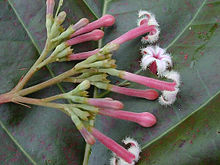
Back كينا Arabic كينا (جنس من النباتات) ARZ Kinə ağacı Azerbaijani کینه آغاجی AZB Хіннае дрэва Byelorussian Хининово дърво Bulgarian সিনকোনা Bengali/Bangla Cincona Catalan Cinchona CEB Chinovník Czech
| Cinchona | |
|---|---|

| |
| C. pubescens | |
| Scientific classification | |
| Kingdom: | Plantae |
| Clade: | Tracheophytes |
| Clade: | Angiosperms |
| Clade: | Eudicots |
| Clade: | Asterids |
| Order: | Gentianales |
| Family: | Rubiaceae |
| Subfamily: | Cinchonoideae |
| Tribe: | Cinchoneae |
| Genus: | Cinchona L. |
| Type species | |
| Cinchona officinalis | |
| Species | |
|
around 38 species; see § Species | |
Cinchona (pronounced /sɪŋˈkoʊnə/ or /sɪnˈtʃoʊnə/[1]) is a genus of flowering plants in the family Rubiaceae containing at least 23 species of trees and shrubs. All are native to the tropical Andean forests of western South America. A few species are reportedly naturalized in Central America, Jamaica, French Polynesia, Sulawesi, Saint Helena in the South Atlantic, and São Tomé and Príncipe off the coast of tropical Africa, and others have been cultivated in India and Java, where they have formed hybrids.
Cinchona has been historically sought after for its medicinal value, as the bark of several species yields quinine and other alkaloids. These were the only effective treatments against malaria during the height of European colonialism, which made them of great economic and political importance. Trees in the genus are also known as fever trees because of their antimalarial properties.[2]
The artificial synthesis of quinine in 1944, an increase in resistant forms of malaria, and the emergence of alternate therapies eventually ended large-scale economic interest in Cinchona cultivation. Cinchona alkaloids show promise in treating Plasmodium falciparum malaria, which has evolved resistance to synthetic drugs. Cinchona plants continue to be revered for their historical legacy; the national tree of Peru is in the genus Cinchona.[3]
- ^ "Cinchona (two pronunciations)". Merriam-Webster, Incorporated. 2019. Retrieved 20 September 2019.
- ^ "fever tree". Oxford English Dictionary (Online ed.). Oxford University Press. (Subscription or participating institution membership required.)
- ^ Deborah Kopka (11 January 2011). Central & South America. Milliken Pub. Co. p. 130. ISBN 978-1429122511. Retrieved 15 April 2013.
© MMXXIII Rich X Search. We shall prevail. All rights reserved. Rich X Search